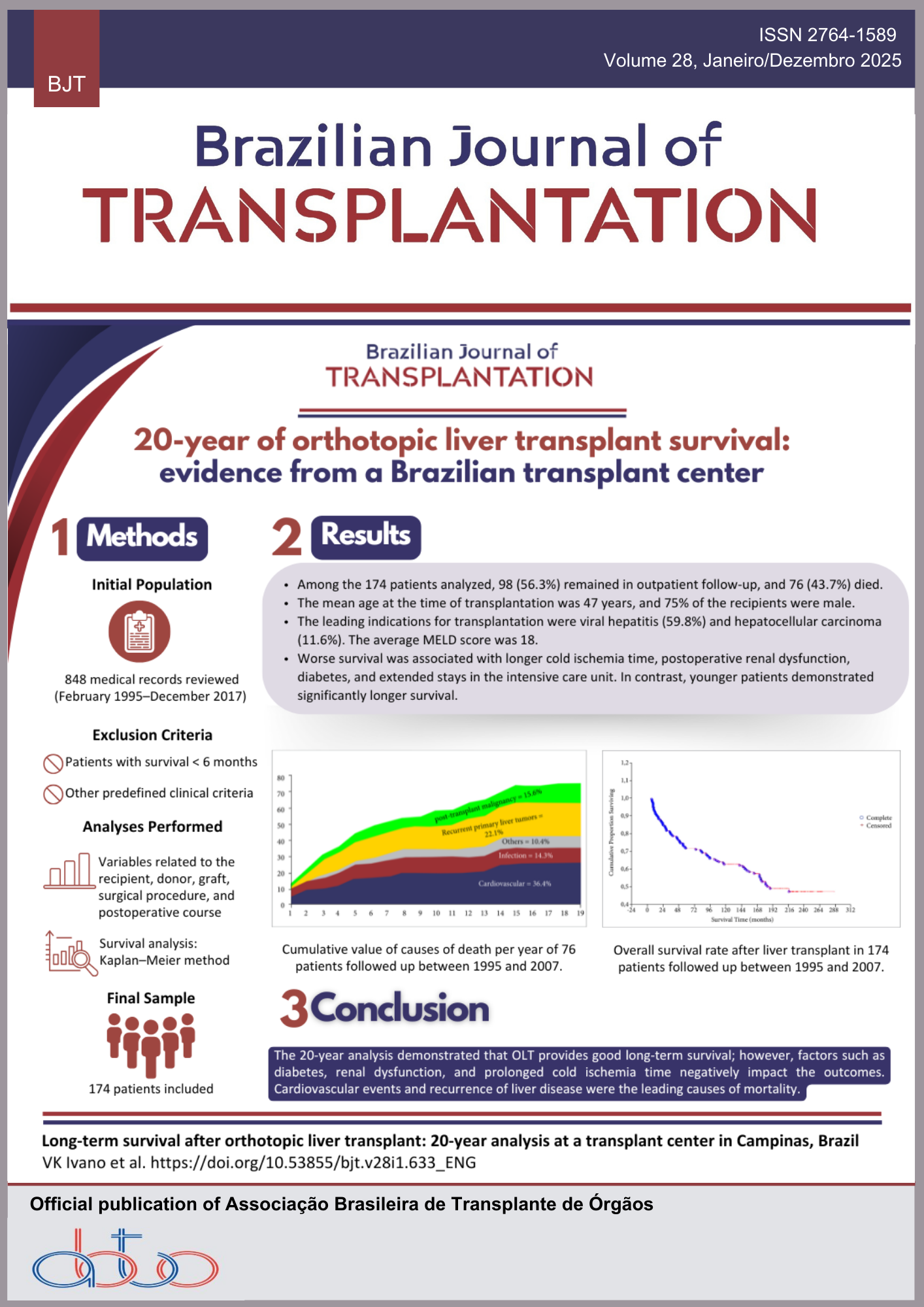Care Bundle: Strategies for Managing Antimicrobials in a Reference Transplant Hospital in Northeastern Brazil
Keywords:
Antimicrobial Stewardship, Pharmacy Service, Hospital, Drug Therapy, TransplantationAbstract
Introduction: Infections by multidrug-resistant bacteria represent a serious public health problem, especially among transplant patients who, due to immunosuppression, become more susceptible to opportunistic infections and resistant pathogens. Antimicrobial Stewardship Programs (AMP) using care bundles have been implemented to promote the rational use of antibiotics and ensure care safety. Objectives: To evaluate the use of a care bundle in managing antimicrobial use in a transplant unit. Methods: This was an observational, descriptive, and retrospective study using data from the institutional AMP database. The antimicrobial management strategies employed between 2020, 2021, and 2023 were analyzed using a quantitative approach and statistical analysis. Results: A total of 398 patients were followed up, with 1,713 strategies recorded, of which 98.2% (n = 1,683) were accepted. The main strategy adopted was to reduce treatment time (30.8%). The most frequent treatment indications were bloodstream infection (47.2%) and upper respiratory tract infection (21.6%). Among the 1,390 antimicrobials monitored, 73.4% belonged to the therapeutic reserve category. Dose adjustment was associated with a 1.87-fold increase in the risk of death, a 5.37-fold increase in escalation, and a 2.33-fold increase in respiratory infections. Dose adjustment also increased treatment time by 10.4 days and hospitalization time by 13.4 days. Bloodstream infections, on the other hand, reduced treatment time by 9.5 days, which curiously increased hospitalization time by 5.2 days. Conclusion: The use of care bundles as part of AMP had a positive impact on the rational use of antimicrobials and relevant clinical outcomes, such as a reduction in the average length of stay and, consequently, exposure to antibiotics, with a possible reduction in resistance. However, mortality was associated with advanced age, the need for dose adjustment, escalation, and respiratory infections. Under-reporting and loss of data reinforce the need for digital technologies for real-time monitoring and continuous training of multi-professional teams.
Downloads
References
1. Barros A. Impacto de um programa de Stewardship para avaliação de antimicrobianos no tempo para início de terapia suscetível in vitro e mortalidade em pacientes com bacteremia por enterobactérias resistentes a carbapenêmicos: um estudo de coorte. Porto Alegre. Thesis [Master in Medicine] – Universidade Federal do Rio Grande do Sul; 2020. https://lume.ufrgs.br/bitstream/handle/10183/230652/001131015.pdf
2. Agência Nacional de Vigilância Sanitária. Diretriz Nacional para Elaboração de Programa de Gerenciamento de Antimicrobianos em Serviços de Saúde. Brasília: Anvisa; 2023 [accessed on 2025 jan 10]. Available in: https://www.gov.br/anvisa/pt-br/centraisdeconteudo/publicacoes/servicosdesaude/publicacoes/DiretrizGerenciamentoAntimicrobianosANVISA2023FINAL.pdf
3. Castro KM. Gestão de antimicrobianos pelo programa Stewardship em um hospital público de ensino: análise da implantação. Fortaleza. Thesis [Master in Pharmacy] – Universidade Federal do Ceará; 2019. https://repositorio.ufc.br/handle/riufc/50511
4. Okumura LM, Silva MMG, Veroneze I. Effects of a bundled Antimicrobial Stewardship Program on mortality: a cohort study. Braz J Infect Dis 2015; 19(3): 246-52. https://doi.org/10.1016/j.bjid.2015.02.005
5. Neves AF, Oliveira CHB, Gonçalves DR, Sudo FSO, Francisconi KT, Angelo LR, et al. Atuação do farmacêutico clínico no programa de Stewardship – categorização de intervenções farmacêuticas em prescrições de antimicrobianos. Braz J Infect Dis 2023; 27(suppl. 1): 102818. https://doi.org/10.1016/j.bjid.2023.102818
6. Pinho CM, Bezerra BL, Lima ABA, Silva DAV, Silva EL, Reis JDO, et al. O uso dos bundles em unidades de terapia intensiva: prevenção e redução das infecções. Rev Enferm Digit Cuid Prom Saúde 2020; 5(2): 117-24. https://doi.org/10.5935/2446-5682.20200021
7. Krempser P, Arreguy-Sena C, Parreira PMSD, Salgueiro-Oliveira AS. Nursing protocol in vascular trauma prevention: peripheral catheterization bundle in urgency. Rev Bras Enferm 2019; 72(6): 1512-8. https://doi.org/10.1590/0034-7167-2018-0457
8. Vesco NL, Fragoso LVC, Beserra FM, Aguiar MIF, Alves NP, Bonates LAM. Infecções relacionadas à assistência à saúde e fatores associados no pós-operatório de transplante hepático. Texto Contexto - Enferm 2018; 27(3): e2150017. https://doi.org/10.1590/0104-070720180002150017
9. Moraes RB, Guillén JAV, Zabaleta WJC, Borges FK. Descalonamento, adequação antimicrobiana e positividade de culturas em pacientes sépticos: estudo observacional. Rev Bras Ter Intensiva 2016; 28(3): 315-22. https://doi.org/10.5935/0103-507X.20160044
10. Locatelli DL, Blatt CR, Werlang MC. Conversion of intravenous to oral antibiotic therapy in an adult intensive care unit. Rev Bras Farm Hosp Serv Saúde 2020; 11(3): 0444. https://doi.org/10.30968/rbfhss.2020.113.0444
11. Santos LKB, Sousa DS, Santos BSP, Silva MCF, Lopes AM, Dourado CSME. Switch oral de antimicrobianos: revisão de escopo. Rev Interfaces 2024; 12(1): 3955-65. https://doi.org/10.16891/2317-434X.v12.e1.a2024.pp3955-3965a
12. Gomes CM, Lazaretto FZ, Camargo AL. Switch therapy of the association of ampicillin and sulbactam in a hospital complex in southern Brazil. Rev Bras Farm Hosp Serv Saude 2021; 12(4): 0690. https://doi.org/10.30968/rbfhss.2021.124.0690
13. Shrayteh ZM, Rahal MK, Malaeb DN. Practice of switch from intravenous to oral antibiotics. SpringerPlus 2014; 3: 717. https://doi.org/10.1186/2193-1801-3-717
14. Freitas TC, Lima ACC, Andrade AGA, Melo DTF, Pedroza FHC, Andrade CC, et al. Utilização da estratégia de step down para desospitalização e realização de terapia antimicrobiana parenteral ambulatorial (OPAT) em pacientes transplantados. Braz J Hea Rev 2022; 5(1): 3134-47. https://doi.org/10.34119/bjhrv5n1-274
15. Conselho Federal de Farmácia. Monitorização Terapêutica de Medicamentos. Brasília: CFF; 2020 [accessed on 2024 nov 26]. Available in: https://www.cff.org.br/userfiles/MONITORIZACAO%20-%20VERSAO%20PARA%20CONSULTA%20PUBLICA.pdf
16. Dellit TH, Owens RC, McGowan Jr JE, Gerding DN, Weinstein RA, Burke JP, et al. Infectious Diseases Society of America and the Society for Healthcare Epidemiology of America guidelines for developing an institutional program to enhance antimicrobial stewardship. Clin Infect Dis 2007; 44(2): 159-77. https://doi.org/10.1086/510393
17. Portela MP. Estudo farmacoeconômico de um programa de gerenciamento antimicrobiano e as consequências da pandemia de COVID-19. Fortaleza. Thesis [PHD in Pharmacy] – Universidade Federal do Ceará; 2024. https://repositorio.ufc.br/handle/riufc/75841
18. Romero JF. Análise de dados de um programa de gerenciamento de antimicrobianos no período anterior e durante a pandemia de COVID-19 em um hospital privado de Fortaleza-CE. Fortaleza. Thesis [Master in Public Healthy] – Universidade Federal do Ceará; 2024. https://repositorio.ufc.br/handle/riufc/77094
19. Abdel Hadi H, Eltayeb F, Al Balushi S, Daghfal J, Ahmed F, Mateus C. Evaluation of Hospital Antimicrobial Stewardship Programs: Implementation, Process, Impact, and Outcomes, Review of Systematic Reviews. Antibiotics 2024; 13(3): 253. https://doi.org/10.3390/antibiotics13030253
20. European Centre for Disease Prevention and Control. Point prevalence survey of healthcare associated infections and antimicrobial use in European acute care hospitals, 2022-2023. Stockholm: ECDC; 2024. https://doi.org/10.2900/88011
21. Sartelli M, Marini CP, McNelis J, Coccolini F, Rizzo C, Labricciosa FM, et al. Preventing and controlling healthcare-associated infections: The first principle of every Antimicrobial Stewardship Program in hospital settings. Antibiotics 2024; 13(9): 896. https://doi.org/10.3390/antibiotics13090896
22. Karanika S, Paudel S, Grigoras C, Kalbasi A, Mylonakis E. Systematic review and meta-analysis of clinical and economic outcomes from the implementation of hospital-based antimicrobial stewardship programs. Antimicrob Agents Chemother 2016; 60(8): 4840-52. https://doi.org/10.1128/AAC.00825-16
23. Albano GD, Midiri M, Zerbo S, Matteini E, Passavanti G, Curcio R, et al. Implementation of a year-long antimicrobial stewardship program in a 227-bed community hospital in Southern Italy. Int J Environ Res Public Health 2023; 20(2): 996. https://doi.org/10.3390/ijerph20020996
24. Secretaria de Estado de Saúde de Mato Grosso. Monitoramento terapêutico da vancomicina: orientações para uso racional e seguro. 2023 [accessed on 2025 jan 10]. Available in: https://www.saude.mt.gov.br/storage/old/files/7dc276400a33df6e347c07ea7cdcd78d1703184207.pdf
25. Chen HP, Tsai YF, Lin JR, Liu FC, Yu HP. Recipient age and mortality risk after liver transplantation: A population-based cohort study. PLoS One 2016; 11(3): e0152324. https://doi.org/10.1371/journal.pone.0152324
26. Choi H, Lee W, Lee HS, Kong SG, Kim DJ, Lee S, et al. The risk factors associated with treatment-related mortality in 16,073 kidney transplantation-A nationwide cohort study. PLoS One 2020; 15(7): e0236274. https://doi.org/10.1371/journal.pone.0236274
27. Avni-Nachman S, Yahav D, Nesher E, Rozen-Zvi B, Rahamimov R, Mor E, et al. Short versus prolonged antibiotic treatment for complicated urinary tract infection after kidney transplantation. Transpl Int 2021; 34(12): 2686-95. https://doi.org/10.1111/tri.14144
28. Zilberberg MD, Shorr AF, Micek ST, Mody SH, Kollef MH. Antimicrobial therapy escalation and hospital mortality among patients with health-care-associated pneumonia: a single-center experience. Chest 2008; 134(5): 963-8. https://doi.org/10.1378/chest.08-0842
Downloads
Published
How to Cite
Issue
Section
License
Copyright (c) 2025 Ana Karolina Pedrosa Ruivo, Mac Dionys Rodrigues da Costa, Alene Barros de Oliveira

This work is licensed under a Creative Commons Attribution 4.0 International License.









